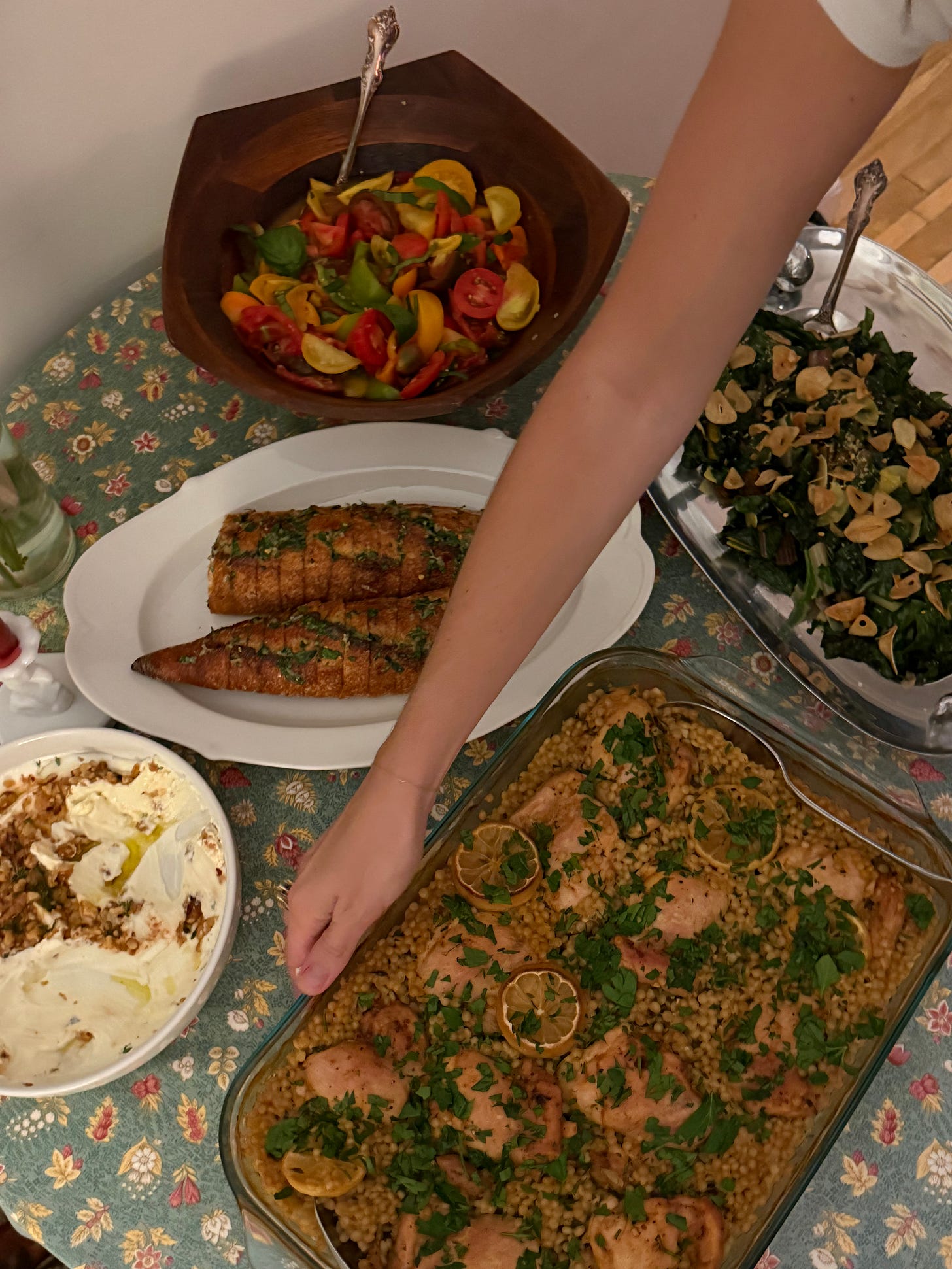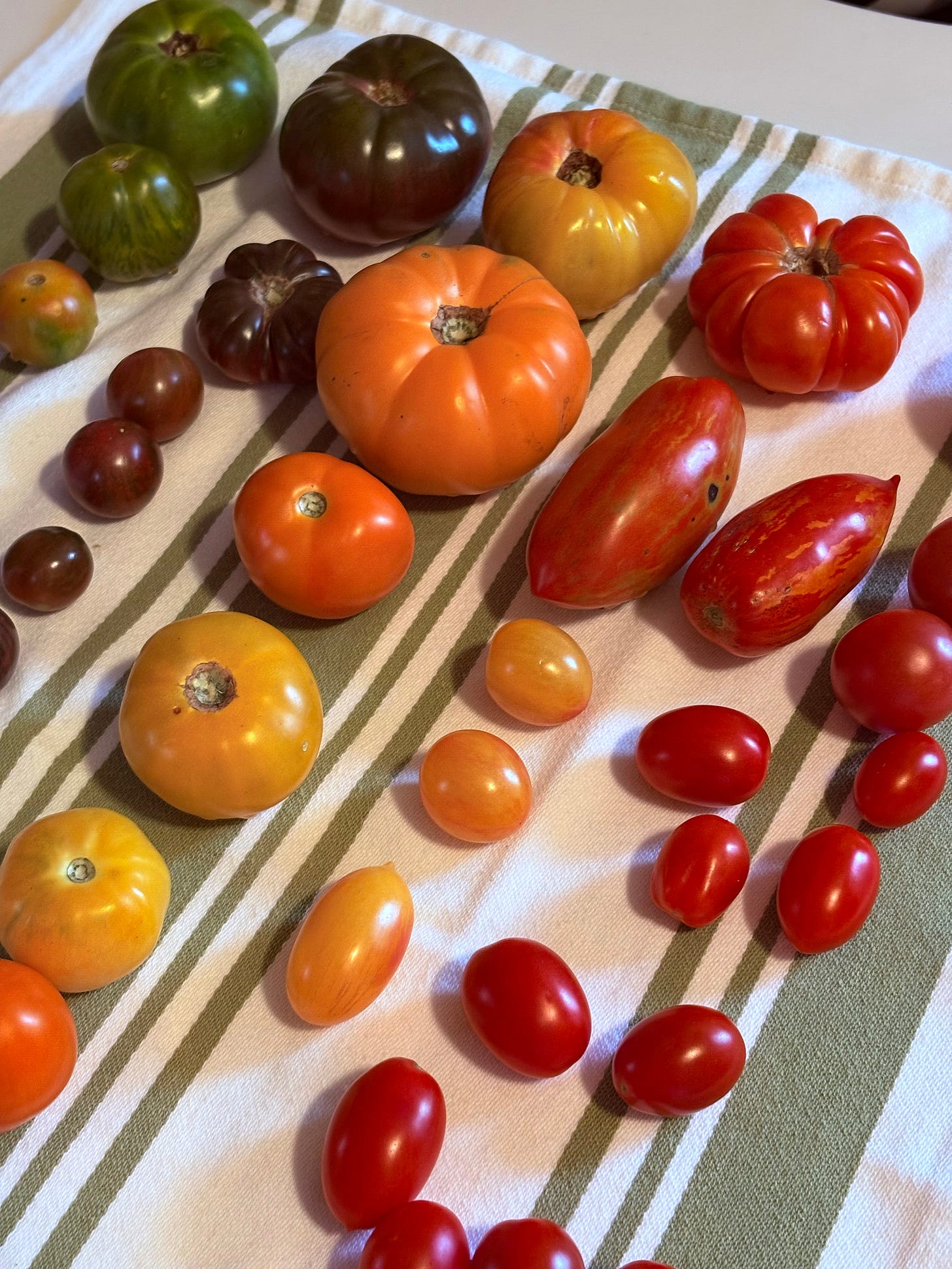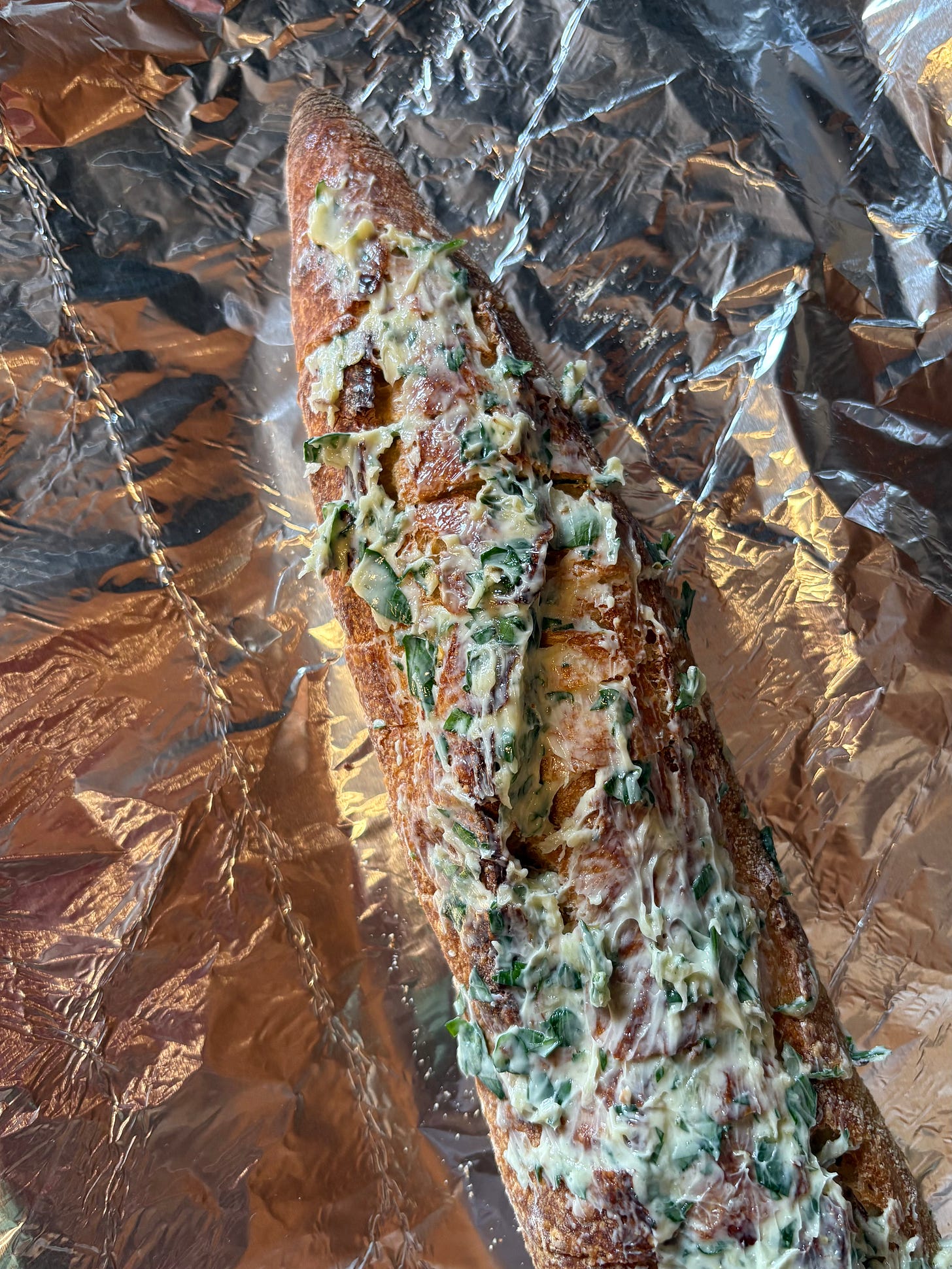Minced Garlic & The End of Civilization
Feeding friends, doing things properly, volcanoes, and timeless wisdom from C.S. Lewis
Last night I threw a dinner party to celebrate the fall equinox. As loyal readers know, I throw an equinox/solstice party on a quarterly basis, in fact, and have done for the past three years and change (I think the first one was in the spring). It is an excellent way to mark the passing of the seasons, catch up with friends, laugh, eat, drink, be merry.
I generally take a sick day on the day of my dinner parties, so I woke up with a fever, and took myself immediately to the bakery down the block for fresh baguettes. I keep meticulous lists, sometimes charted out by the hour so that no errand is left unrun, no element of the meal un-mis-en-placed. And so that I don’t forget to shower. Get baguettes was in the “morning” section of my to-do list, along with moving all the furniture.
By afternoon and according to plan, I was smashing, slicing, grating, mincing garlic for the various dishes of the evening, each of which called for garlic in its unique incarnation. Smashing for the chicken, slicing for the chard, grating for the garlic bread (it’s a good thing that my friends are hearty, because the garlic bread may have killed a more fragile woman). For the tomato salad, the garlic needed to be minced, finely. I felt, correctly, that the finely was imperative in this case. With it, there would also be finely minced shallot (just a bit!), a dash of champagne vinegar, a dash of olive oil, salt and pepper. Basil (obviously) That’s it! It all had to be light—barely noticeable, there only to accentuate the flavor of my darling greenmarket tomatoes. September tomatoes. Perfect, perfect tomatoes.
I’m kind of a psycho when it comes to a fine mince. But I’m kind of a psycho about Quality in general, and I believe that the line that marks Quality between a loose mince and a fine mince is quite clear. As you can imagine, for someone with mediocre (even that is generous) knife skills, achieving a psycho-level fine mince gives one ample time to think.
I thought first about how when people compliment my cooking (they do!), I should tell them that the reason it tastes so good is because I spend 3x the amount of time mincing my garlic than they (presumably not psychos) do, and that the extra time is the only thing that differentiates my cooking from theirs. I believe this to be true. Also most people are too shy about salt. I’m the opposite of a psycho (loose as hell) about salt.
I followed my thoughts to their logical conclusion: satisfied self discovery. I am the type of person who is only interested in doing something if I can do it Right. I define what Right is, as we are all entitled to do. Right (Quality) is recognizable.
Then I started thinking about volcanoes, which has been a topic frankly constantly on my mind since I read an essay entitled “When Sleeping Volcanoes Wake: The next global disaster may be triggered by a catastrophic eruption. How can we prepare for the fire beneath our feet?” from Aeon. I highly recommend reading the whole thing, but to summarize: there are 1,302 volcanoes that we know have been active sometime in the past 12,000 years (our current geologic epoch, the Holocene, started about 12,000 years ago). Of those 1,302 known volcanoes, less than half are equipped with any kind of monitoring instruments (i.e. there are ~702 volcanoes on earth that might be up to something, but we have no way of knowing). The most powerful eruptions generally happen when volcanoes have been DORMANT FOR A CENTURY OR MORE, so even for the ~600 volcanoes we monitor, the monitoring may not mean much until eruption is imminent. ON TOP OF THAT, it is reasonable to expect an eruption every ten years from a volcano that we did not previously know was a volcano at all.
The essay proceeds to terrorize its reader with in depth explanations of the types of large-scale, far reaching disasters that a large eruption can visit upon the earth. Of course, in the immediate vicinity of an eruption, there’s lava, rock and mud slides (google lahar), flaming rock and ash particles raining from the sky, etc. But even on the other side of the world, no one is safe. Prepare for climate chaos, famine, pandemics, and the rise and fall of civilizations. If two large eruptions take place successively like they did in the mid-6th century, expect a little ice age and the possible decimation of 10-25% of the WORLD’S POPULATION.
Knowing all this fills me with an irrational sort of giddiness. At any moment, everything could change! For the worse naturally, in the case of a massive volcanic eruption, but there’s nothing I can do about that. To be clear, this odd joy at my utter helplessness is neither nihilistic (what does it matter if the mince is fine or loose if a volcano could wipe us all out—randomly and without warning) or hedonistic (why would I spend my time mincing this garlic when I could be, I don’t know, having sex or doing cocaine or both or whatever). It’s something else, which called to mind a C.S. Lewis essay that’s been making the rounds of late.
In 1948, Lewis published an essay entitled “On Living in an Atomic Age,”1 which opens thusly (you may understand why people today seem to connect with it):
In one way we think a great deal too much of the atomic bomb. ‘How are we to live in an atomic age?’ I am tempted to reply: ‘Why, as you would have lived in the sixteenth century when the plague visited London almost every year, or as you would have lived in a Viking age when raiders from Scandinavia might land and cut your throat any night; or indeed, as you are already living in an age of cancer, an age of syphilis, an age of paralysis, an age of air raids, an age of railway accidents, an age of motor accidents.’
In short, our predicament is not new, though the trappings may seem different (or progressively more horrifying). The volcanoes have always been there. There is no point in getting worked up about each new “chance of a painful and premature death” in a “world which already bristled with such chances and in which death itself was not a chance at all, but a certainty.” The volcanoes!
What people really have trouble facing is the idea that this whole thing (us, civilization, humanity) may come to nothing. Lewis makes his reader face it: we are on a ship that’s sinking (yes, very slowly), but whether the mast snaps in half or the boiler blows up, it will sink. The question is whether we believe that there is something else outside of Nature as we know it—whether there is some other existence waiting. As a Christian, Lewis believes there is, but even if you don’t share that belief, his prescription for what to do while you’re waiting to find out for sure can work for everyone:
Stop thinking about it so much. Stop worrying about your own survival so much. Stop worrying even about the survival of civilization so much. He says “If we are all going to be destroyed by an atomic bomb let that bomb when it comes find us doing sensible and human things: praying, working, teaching, reading, listening to music, bathing the children, playing tennis, chatting to our friends over a pint and a game of darts—not huddled together like frightened sheep and thinking about bombs.”
When the lahar comes for me, I will be finely mincing my garlic so that the tomato salad I feed to my friends is perfect—so that no one even knows for sure that there’s garlic in it, but there is. And when they find us turned to stone under the ashes, we will be holding hands around the table.
A Menu for the Fall Equinox
Simple Tomato Salad
mix of delicious perfect September tomatoes
little scoop of finely minced garlic
medium scoop (2-3x the amount of garlic visually) finely minced shallot
dash of vinegar (I used champagne)
glug of olive oil
salt
white pepper
basil
Slice tomatoes in different ways (cherry tomatoes in half, larger tomatoes in wedges, medium tomatoes in flat slices). Mix everything together in a bowl. Yum!
Garlicky Chard
two large bunches of Swiss chard or rainbow chard (same thing)
8 large cloves of garlic
olive oil
zest of 1 lemon
Clean the chard and slice into ~3/4 inch strips, including stalks. Thinly slice the garlic. Fry 3 cloves worth of thinly sliced garlic (to make garlic chips). Start with the garlic in cold oil, then heat slowly until sizzling, stir regularly until golden brown, use a slotted spoon to transfer to a paper towel lined plate.
Cook the rest of the sliced garlic (5 cloves) and a hefty pinch of salt in olive oil until fragrant. Add the chard in bunches letting it wilt slightly before adding more, cover and cook for ~3-5 minutes. Plate and top with lemon zest, garlic chips, red pepper flakes optional.
Lemon & Thyme Pearled Couscous & Chicken
enough chicken thighs for however many people you have
enough couscous for however many people you have (1/3 cup=1 serving)
however many cups of couscous you have x2 cups of chicken stock (i.e. for one cup couscous, you need 2 cups stock)
minced garlic (loose mince is fine) + smashed garlic for marinade
chopped onion
fresh thyme
lemon juice and lemon slices
olive oil
paprika
salt & pep
parsley for garnish
Marinate the chicken thighs in lemon juice, olive oil, smashed garlic, paprika, salt and pepper. When it’s time, quickly cook the chicken (3ish min on each side) so that it’s browned up a bit. Put olive oil, garlic, onion, thyme and salt and pepper in the same pan you cooked the chicken in and soften until onion is translucent. Add couscous to the pan and toast for a few minutes, stirring to coat in oil. Add chicken stock and bring to a boil. Nestle chicken back in the pan and add lemon slices, put in the oven at 400 for 15-20 min, garnish with parsley. Easy peasy!
Garlic Bread
too much garlic (grated)
softened butter
fresh chopped parsley
red pepper flakes
salt and pepper
fresh baguette
Mix everything (except the baguette) together in a bowl. Slice the baguette crosswise, not cutting all the way through. Spoon softened butter mixture generously into each slice, spread remaining butter over the top. Wrap in tinfoil and bake at 350 for 10 minutes, unwrap and bake for another 5 minutes.
Fat Archies
Recipe out of my Crumbs cookbook (thanks, Lexy <3). If the dogs get to the dough and eat half, you’ll only get 11 cookies (not 18).
From the collection Present Concerns.






What a lovely way to honour your friends and the passing of the seasons. I am very impressed by your cooking and your effort. Maybe that's where I've been going wrong. And yes, I think this is a much better way to meet the potential end times.
Love this!